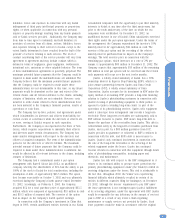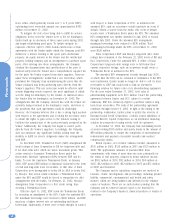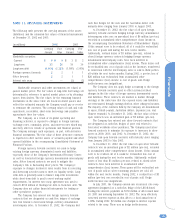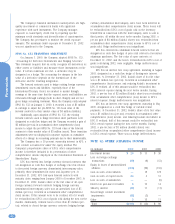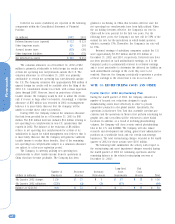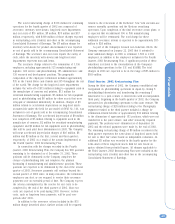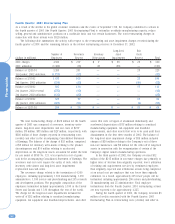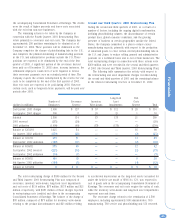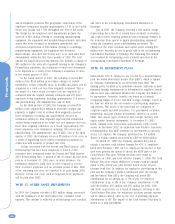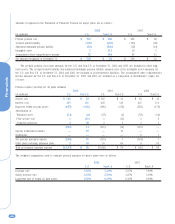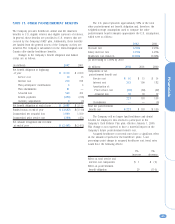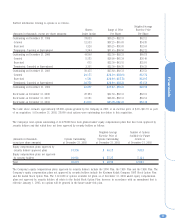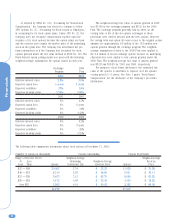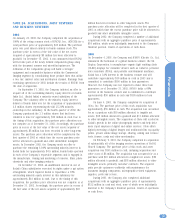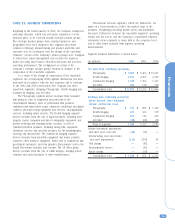Kodak 2002 Annual Report Download - page 66
Download and view the complete annual report
Please find page 66 of the 2002 Kodak annual report below. You can navigate through the pages in the report by either clicking on the pages listed below, or by using the keyword search tool below to find specific information within the annual report.
Financials
66
and development positions. The geographic composition of the
employees terminated included approximately 1,110 in the United
States and Canada and 1,590 throughout the rest of the world.
The charge for the long-lived asset impairments includes the
write-off of $61 million relating to sensitizing manufacturing
equipment, lab equipment and leasehold improvements, and other
assets that were scrapped or abandoned immediately and
accelerated depreciation of $33 million relating to sensitizing
manufacturing equipment, lab equipment and leasehold
improvements, and other assets that were to be used until their
abandonment within the first three months of 2002. The total
amount for long-lived asset impairments also includes a charge of
$43 million for the write-off of goodwill relating to the Company’s
PictureVision subsidiary, the realization of which was determined
to be impaired as a result of the Company’s acquisition of Ofoto
in the second quarter of 2001.
In the fourth quarter of 2001, the Company reversed $20
million of the $134 million in severance charges as certain
termination actions, primarily those in EAMER and Japan, will be
completed at a total cost less than originally estimated. This is
the result of a lower actual severance cost per employee as
compared with the original amounts estimated and 275 fewer
employees being terminated, including approximately 150 service
and photofinishing, 100 administrative and 25 R&D.
In the third quarter of 2002, the Company reversed $14
million of the original $134 million in severance charges due
primarily to higher rates of attrition than originally expected,
lower utilization of training and outplacement services by
terminated employees than originally expected and termination
actions being completed at an actual cost per employee that was
lower than originally estimated. As a result, approximately 225
fewer employees were terminated, including 100 service and
photofinishing, 100 administrative and 25 R&D. Also in the third
quarter of 2002, the Company reversed $3 million of exit costs as
a result of negotiating lower contract termination payments in
connection with business or product line exits.
Actions associated with the Second and Third Quarter, 2001
Restructuring Plan have been completed. A total of 2,200
personnel were terminated under the Second and Third Quarter,
2001 Restructuring Plan. A portion of the severance had not been
paid as of December 31, 2002 since, in many instances, the
terminated employees could elect or were required to receive
their severance payments over an extended period of time. Most
of the remaining exit costs are expected to be paid during 2003.
However, certain exit costs, such as long-term lease payments,
will be paid after 2003.
NOTE 15: OTHER ASSET IMPAIRMENTS
In 2001, the Company recorded a $77 million charge associated
with the bankruptcy of the Wolf Camera Inc. consumer retail
business. This amount is reflected in restructuring costs (credits)
and other in the accompanying Consolidated Statement of
Earnings.
Also in 2001, the Company recorded a $42 million charge
representing the write-off of certain lease residuals, receivables
and capital assets resulting primarily from technology changes in
the transition from optical to digital photofinishing equipment
within the Company’s onsite photofinishing operations. The
charges for the lease residuals and capital assets totaling $19
million were recorded in cost of goods sold in the accompanying
Consolidated Statement of Earnings. The remaining $23 million
was recorded in restructuring costs (credits) and other in the
accompanying Consolidated Statement of Earnings.
NOTE 16: RETIREMENT PLANS
Substantially all U.S. employees are covered by a noncontributory
plan, the Kodak Retirement Income Plan (KRIP), which is funded
by Company contributions to an irrevocable trust fund. The
funding policy for KRIP is to contribute amounts sufficient to meet
minimum funding requirements as determined by employee benefit
and tax laws plus additional amounts the Company determines to
be appropriate. Generally, benefits are based on a formula
recognizing length of service and final average earnings. Assets in
the fund are held for the sole benefit of participating employees
and retirees. The assets of the trust fund are comprised of
corporate equity and debt securities, U.S. government securities,
partnership and joint venture investments, interests in pooled
funds, and various types of interest rate, foreign currency and
equity market financial instruments. At December 31, 2001,
Kodak common stock represented approximately 3.4% of trust
assets. In December 2002, in connection with Wilshire Associates’
recommendation that KRIP eliminate its investments in specialty
sector U.S. equities, the Company purchased the 7.4 million
shares of Kodak common stock held by KRIP for $260 million.
On March 25, 1999, the Company amended this plan to
include a separate cash balance formula for all U.S. employees
hired after February 1999. All U.S. employees hired prior to that
date were granted the option to choose the KRIP plan or the
Cash Balance Plus plan. Written elections were made by
employees in 1999, and were effective January 1, 2000. The Cash
Balance Plus plan credits employees’ accounts with an amount
equal to 4% of their pay, plus interest based on the 30-year
treasury bond rate. In addition, for employees participating in this
plan and the Company’s defined contribution plan, the Savings
and Investment Plan (SIP), the Company will match SIP
contributions for an amount up to 3% of pay, for employee
contributions of up to 5% of pay. Company contributions to SIP
were $14 million, $15 million and $11 million for 2002, 2001
and 2000, respectively. As a result of employee elections to the
Cash Balance Plus plan, the reductions in future pension expense
will be almost entirely offset by the cost of matching employee
contributions to SIP. The impact of the Cash Balance Plus plan is
shown as a plan amendment.



